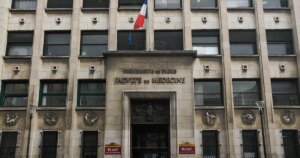
For more than half a century, a 163-square-kilometer U.S. territory in the Caribbean Sea has been repeatedly bombed by that country’s military. Between the 1940s and 2000, every year, 2,000 tons of ammunition fell on Vieques, a small island that is part of the Puerto Rico archipelago. The US Navy has transformed this Caribbean paradise with crystal-clear waters into the most realistic recreation of a war zone possible: after expelling thousands of residents and taking control of two-thirds of the island and its resources, the Navy established a training base and a shooting range there to carry out artillery tests and other military exercises with which it terrorized the local population, forced to live among the explosions on a narrow strip of land.
After one of those bombs killed a civilian, massive protests forced the Navy to leave Vieques in 2003. Although routine military exercises have continued in Puerto Rico ever since, the militarization that the island experienced during World War II and the Cold War, periods in which the territory served as a military bastion for the United States due to its strategic location in the Caribbean, was no longer seen. Until now. Amid growing tension with Venezuela, the United States has increased its military presence in Puerto Rico and surrounding areas, while reopening military bases in the territory.
This Monday, General Dan Caine, Chief of Staff, was in Puerto Rico. The Pentagon explained that the purpose of the visit by the top American military commander was to thank the troops stationed in the territory ahead of Thanksgiving Day, which is celebrated on Thursday. However, second The New York TimesCaine plans to meet with soldiers and senior officers from the Southern Command to assess the readiness of the deployed forces.
The Southern Command is responsible for the military deployment ordered by Donald Trump in the Caribbean in recent weeks, while the United States is evaluating options to force the fall of Venezuelan President Nicolás Maduro, who it officially considers an illegitimate leader linked to drug trafficking to the United States. Puerto Rico is home to 5,000 of the nearly 15,000 U.S. troops sent to the area for what the Trump administration called an anti-drug trafficking operation, which included the sinking of at least 21 suspected drug vessels in extrajudicial attacks that killed more than 80 people.
Caine’s trip to Puerto Rico comes at a time when the Trump administration is hinting at the start of a “new phase” in the so-called Operation Southern Lance. This new phase risks including actions within Venezuelan territory for the first time. At the same time, the door was also opened to a telephone conversation between Trump and Maduro with the aim of exploring the feasibility of a diplomatic channel, according to sources close to the contacts cited by the Axios portal.
This week is Caine’s second visit to Puerto Rico in recent months. The Chief of the General Staff was in the territory on September 9th along with the Secretary of Defense, Pete Hegseth. Both were received by the governor of Puerto Rico, Jenniffer González, a faithful ally of Trump. The councilor, from the conservative New Progressive Party (PNP), which advocates for Puerto Rico to become the 51st U.S. state, supported the island’s growing militarization.
“We thank President Trump and his administration for recognizing the strategic importance of Puerto Rico to the national security of the United States and for their fight against drug cartels and narco-dictator Nicolás Maduro,” González said in September.
Since late August, F-35 fighter jets, Navy destroyers and helicopter gunships have arrived in Puerto Rico and amphibious training and flight operations, as well as landing and infiltration maneuvers, have been carried out. The largest and most advanced aircraft carrier in the United States, the Gerard Fordand more than a dozen warships.
open wounds
The military deployment to the Caribbean meant the reopening of a naval base closed more than 20 years ago in Puerto Rico. Opened in 1943, Roosevelt Roads was one of the largest US Navy bases in the world until its closure in 2004. Roosevelt Roads is located in the municipality of Ceiba, on the eastern tip of the island, just 26 kilometers from Vieques. The naval base that opened in Vieques in the 1940s was conceived as an extension of Roosevelt Roads and closed just after the Navy left the island following the death of David Sanes, a 35-year-old Vieques man who worked as a security guard at a Navy surveillance post where troops accidentally dropped a bomb in 1999.
Now, Roosevelt Roads is back in operation, reviving fears that the military could return to Vieques 20 years after people managed to remove them. Even today, Vieques continues to live with the consequences of those 60 years of military presence. The U.S. government has not completed the cleanup of the remnants of unexploded ordnance that the Navy left behind when it left. And several studies show that Viequenses have unusually high concentrations of toxic metals such as mercury, uranium and arsenic in their hair and urine, while they are more likely to die from cancer than other Puerto Ricans, with significantly higher rates of heart disease, liver disease, diabetes and infant mortality.
Last week, those wounds reopened after it became known that since last January the military carrying out maneuvers in Puerto Rico may have had ammunition in Vieques. After the revelation, former Puerto Rican Independent Party (PIP) gubernatorial candidate Juan Dalmau, who came second in last year’s election, called on Governor González to stop any military reuse of Vieques.
“It is unacceptable that, to the offense of the United States Navy’s failure to comply with its obligation to repair the great environmental damage caused by 60 years of bombing in Vieques, the intention to use the island as a military dump is added. Even more scandalous is that, knowing the great collective sacrifice of the fight for peace in Vieques, this administration passively takes on this crime,” Dalmau wrote in a public letter addressed to the governor together with other politicians of the his country. party.
González, for his part, responded that Vieques “has not been on the map of discussions” about deployment to Puerto Rico and the Caribbean amid tensions with Venezuela. “Not for (military) exercises, not at all absolutely,” he said. The councilor specified that, in addition to Roosevelt Roads, there are soldiers in the municipality of Aguadilla (in the north-east of the island) and in Campo Santiago, in Salinas, in the south.
The US Federal Aviation Administration (FAA) recently issued an early warning for all airspace over Puerto Rico, warning of a “potentially hazardous situation” related to increased military operations in the area. The alert is in force from 18 November 2025 to 16 February 2026.
As happened in Vieques, this time too the presence of the military was greeted with both political and citizen protests. In an interview with EL PAÍS this month, New York Democratic Rep. Nydia Velázquez, the highest-ranking Puerto Rican in Congress, was against the militarization of her home island and the United States using it “as a platform to attack Venezuela.” And demonstrations were seen in the streets of Puerto Rico with banners demanding: “Gringos out of the Caribbean!”





